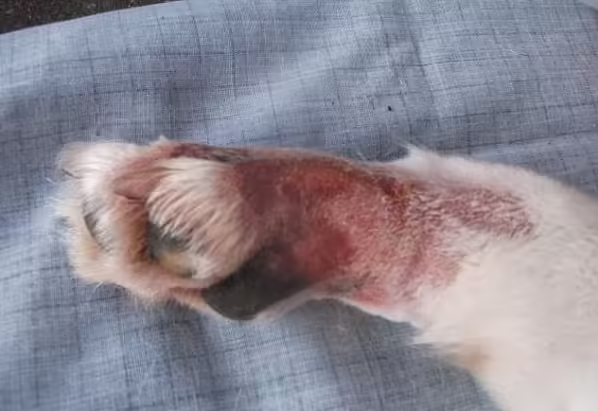Alabama Rot Dogs, also known as Cutaneous and Renal Glomerular Vasculopathy (CRGV), is a devastating condition affecting dogs, particularly in the United Kingdom . This article delves into various aspects of Alabama Rot in dogs, providing essential information for dog owners to recognize symptoms, understand treatment options, and stay informed about its prevalence in 2024.

Table of Contents related to Alabama Rot Dogs
Alabama Rot Dogs: What You Need to Know
Alabama Rot primarily manifests through skin lesions and can lead to severe kidney damage. Initially identified in Alabama, USA, the condition has become notably prevalent in the UK, particularly affecting specific regions such as Dorset and the New Forest. Understanding this disease is crucial for dog owners, as timely recognition and intervention can save lives.
Alabama Rot Dogs Symptoms
Recognizing the symptoms of Alabama Rot is essential for early intervention. The primary symptoms include:
- Skin Lesions: The most notable sign, lesions often appear as swelling or ulcerated areas on the skin, typically on the legs and paws.
- Lethargy: Affected dogs may exhibit reduced energy levels or reluctance to engage in normal activities.
- Decreased Appetite: Many dogs will show a lack of interest in food.
- Vomiting and Diarrhea: Gastrointestinal symptoms may occur, indicating systemic involvement.
If you observe any of these symptoms in your dog, seek veterinary attention promptly.
Alabama Rot Treatment
Currently, there is no definitive cure for Alabama Rot, making early detection and treatment vital. Treatment often involves:
- Supportive Care: This includes hospitalization and administration of intravenous fluids to support kidney function.
- Antibiotics and Anti-inflammatories: These may be prescribed to manage infections and reduce inflammation.
- Monitoring: Regular blood tests are essential to assess kidney function and overall health.
- Preventative Measures: Avoiding walks in areas where Alabama Rot cases have been reported can reduce exposure risk.
Veterinary guidance is crucial, and any signs of the condition should prompt immediate consultation.
Alabama Rot Map: Tracking Cases
In 2024, various resources, including veterinary associations and local pet organizations, have created maps to track the prevalence of Alabama Rot across the UK. These maps indicate regions where cases have been reported, helping dog owners make informed decisions about where to walk their pets. Staying updated on these maps can be crucial for avoiding areas with higher risks of exposure. Do check Common Skin Diseases in Dogs to keep your dog safe.
Alabama Rot Symptoms in Dogs: A Closer Look

When examining Alabama Rot symptoms in dogs, it’s essential to consider the following:
- Initial Lesions: These may appear as small, red spots or swelling, often on the lower limbs.
- Progression to Ulcers: If left untreated, these lesions can progress to deep, painful ulcers.
- Kidney Damage: Following the appearance of skin lesions, dogs may develop acute kidney failure, leading to more severe symptoms like increased thirst, urination changes, and abdominal pain.
Awareness of these symptoms can help in seeking timely veterinary care.
Alabama Rot 2024: Current Trends and Data
As of 2024, the understanding and reporting of Alabama Rot cases have evolved. Increased awareness among dog owners and veterinarians has led to better reporting and tracking of cases. This year has seen heightened vigilance in areas historically affected, such as Dorset and the New Forest. Dog owners are encouraged to remain aware of local alerts and guidance regarding Alabama Rot.
Alabama Rot Dorset and the New Forest
Dorset and the New Forest have been notably impacted by Alabama Rot. These areas have reported numerous cases over the years, prompting local veterinarians and dog owners to exercise caution. If you frequent these regions, consider avoiding muddy or wooded areas where dogs might come into contact with the disease-causing pathogens.
Alabama Rot Causes
The exact causes of Alabama Rot are still under investigation. However, it is believed that exposure to certain environmental factors, including contaminated soil or water, may trigger the condition. Certain breeds appear more susceptible, although any dog can potentially develop Alabama Rot. Keeping your dog away from known risk areas can reduce the likelihood of exposure.
Alabama Rot UK 2024: Staying Informed
As the situation evolves, staying informed about Alabama Rot in the UK is crucial for dog owners. Regularly checking veterinary resources, local pet owner groups, opting for some Pet Insurance and disease tracking maps can help you stay aware of any outbreaks in your area. Awareness and education are key to minimizing the risks associated with this serious condition.
FAQ’s related to Alabama Rot Dogs
1. What is Alabama Rot?
Alabama Rot, or Cutaneous and Renal Glomerular Vasculopathy (CRGV), is a serious disease in dogs characterized by skin lesions and potential kidney failure. It was first identified in the United States but has become notably prevalent in the UK.
2. What are the symptoms of Alabama Rot in dogs?
Common symptoms include:
- Skin lesions that appear as red spots or ulcers, primarily on the legs and paws.
- Lethargy and decreased activity levels.
- Reduced appetite and potential vomiting or diarrhea.
- Signs of kidney failure, such as increased thirst or changes in urination.
3. How is Alabama Rot diagnosed?
Diagnosis typically involves a veterinary examination, blood tests, and sometimes skin biopsies. The presence of characteristic lesions along with kidney function impairment often indicates Alabama Rot.
4. What treatment options are available for Alabama Rot?
Treatment may include:
- Intravenous fluids to support kidney function.
- Antibiotics to prevent or treat secondary infections.
- Anti-inflammatories to manage symptoms.
- Regular monitoring of kidney function and overall health.
5. Is Alabama Rot contagious?
No, Alabama Rot is not contagious. It is believed to be caused by environmental factors, not by direct contact between dogs.
6. Where has Alabama Rot been reported?
Alabama Rot cases have been reported primarily in the UK, with significant incidents in regions like Dorset and the New Forest. Local maps and resources can help track areas with reported cases.
7. What can I do to prevent my dog from contracting Alabama Rot?
To reduce the risk of exposure:
- Avoid walking your dog in muddy or wooded areas known for recent cases.
- Keep your dog away from stagnant water and muddy puddles.
- Rinse and dry your dog’s legs and belly after walks in potentially affected areas.
8. What should I do if I suspect my dog has Alabama Rot?
If you notice any symptoms, particularly skin lesions or signs of kidney distress, contact your veterinarian immediately for advice and possible examination.
9. Is there a vaccine for Alabama Rot?
Currently, there is no vaccine available to protect dogs from Alabama Rot. Awareness and early intervention are crucial for managing the disease.
10. What is the prognosis for dogs with Alabama Rot?
The prognosis can vary. Early detection and treatment can improve outcomes, but many cases can lead to severe kidney damage and can be fatal. Regular veterinary check-ups are important for monitoring any potential issues.
11. How can I stay updated on Alabama Rot cases in my area?
You can stay informed through local veterinary practices, pet organizations, and online resources that provide updates and maps on Alabama Rot cases in your region.
Conclusion
Alabama Rot is a serious condition that demands attention from dog owners. Understanding the symptoms, treatment options, and current trends can empower you to protect your furry friend. Regular veterinary check-ups, especially after walks in high-risk areas, are essential for early detection and successful management of this condition. Stay informed, and take proactive steps to ensure your dog’s health and safety.
Do check our popular articles: